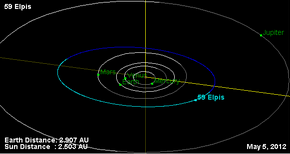|
59 Elpis
59 Elpis is a large main belt asteroid that orbits the Sun with a period of 4.47 years. It is a C-type asteroid, meaning that it is very dark and carbonaceous in composition. In the Tholen scheme it has a classification of CP, while Bus and Binzen class it as type B.[6] Elpis was discovered by Jean Chacornac from Paris, on September 12, 1860. It was Chacornac's sixth and final asteroid discovery. A controversy arose over the naming of Elpis. Urbain Le Verrier, director of the Paris Observatory, at first refused to allow Chacornac to name the object, because Leverrier was promoting a plan to reorganize asteroid nomenclature by naming them after their discoverers, rather than mythological figures. A protest arose among astronomers. At the Vienna Observatory, Edmund Weiss, who had been studying the asteroid, asked the observatory's director, Karl L. Littrow, to name it. Littrow chose Elpis, a Greek personification of hope, in reference to the favorable political conditions in Europe at the time. In 1862, Leverrier permitted Chacornac to choose a name, and he selected "Olympia" at the suggestion of John Russell Hind.[7] However, Elpis is the name that stuck.[8] Elpis has been studied by radar.[9] References
External links
|
||||||||||||||||||||||||||||||||||||||||||||||||||||||||||||
Portal di Ensiklopedia Dunia
